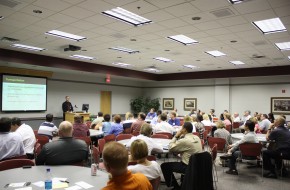Public Engagement
The public engagement process was guided and assisted by three core groups:
- Citizen Stakeholder Groups. Eight Citizen Stakeholder Groups were formed–one for each of the eight plan elements. The stakeholder groups were composed of interested citizens who volunteered to identify issues and develop goals for their element.
- Healthy Communities Oversight Group. This group was charged with helping ensure that the goals and policies in planokc were consistent with the city’s public health objectives. This group was primarily composed of public health experts and individuals working to understand the connections between health and the built environment, with the end goal of planning for a healthier community, economy, and environment.
- Citizen Advisory Team. The Citizen Advisory Team was a 27-member, Mayor-appointed group that provided advice at key points in the planning process, responding to the work done by planners and stakeholder groups. Members represented a cross-section of interests in the community, including representatives from each of the eight citizen stakeholder groups, the Healthy Communities Oversight Group, the development sector, public schools, and the community at large. Each ward was represented by a member of the Planning Commission or City Council.
The broader public engagement process was divided into a two-part process to identify the issues, goals, and policies that form the foundation of planokc.
Part 1: Awareness and Outreach
This initial outreach was designed to make the public aware of planokc and provide basic information on community planning and opportunities for future involvement. Outreach included:
- Community Kickoff. An initial Kickoff meeting was held to explain the process to the community, share preliminary information that had been collected and invite residents to participate in future events.
- Presentation Circuit. City planners spoke to various professional, non-profit, and neighborhood groups to introduce planokc and share ways they could be involved. The Presentation Circuit reached approximately 50 groups and over 1,300 people.
Part 2: Goals, Policies, and Vision Development
Part 2 focused on gathering a wide range of community input that was used to identify issues and challenges, identify broad community goals, and a vision for the future. Input from community members was gathered in a variety of ways, including:
- Neighborhood Workshop. A neighborhood workshop was held at Langston-OKC with assistance from Neighborhood Alliance. Approximately 160 neighborhood leaders and residents helped identify neighborhoods’ strengths and challenges.
- Meeting in a Box. Meeting in a Box was a self-guided activity that allowed citizens to host their own planokc meeting to discuss ten livability indicators, rate their neighborhood based on their discussion, identify the importance of each indicator, and report back to planokc staff.
- Joint Commission/Committee Workshop. Planners held a joint workshop for City design committees and commissions and the Planning Commission. The focus of the workshop was to share the strengths and challenges of each area of the city.
- Greater Oklahoma City Chamber of Commerce Retreat. The retreat allowed participants to discuss the challenges facing the city and develop strategies and ideas for addressing those challenges.
- Presentation to School Districts and City Managers. planokc staff hosted a special meeting for area school districts and city managers of neighboring jurisdictions to share information about the process and invite them to participate in Stakeholder Groups.
- Community Updates and Open Houses. Several large community presentations were conducted to build awareness and inform residents on work completed.
- Growth Scenarios Workshops. The Growth Scenarios Workshops focused on the alternative approaches to accommodating our city’s future growth. The survey component was also available on-line for residents who were unable to attend the workshops.
- Focus groups. Several focus groups were held with members of the real estate industry, and neighborhood and environmental advocates in the summer and fall of 2014 in order to receive input on planokc policies.
- Community Surveys. Using a variety of surveying techniques was essential to reaching the widest audience possible. These surveys included:
- planokc Vision Survey. The 2011 survey invited residents to provide a word or a short phrase to describe their vision of a future Oklahoma City and what they believed should be the overall goal of planokc.
- planokc CrowdGauge Survey. This online activity asked participants to rank their priorities for Oklahoma City, informed them on how City policies or actions could impact their priorities, and asked them to identify the policies or actions they support most.
- Housing Survey. As part of the Oklahoma City Housing Study, this survey gauged the existing and future housing demands of residents. A random survey was distributed via mail, along with a targeted survey of university students, young professionals, and recent arrivals to the city.
- Community Appearance Survey. In order to understand what community appearance issues Oklahoma City faces, and what design elements residents consider appealing, this survey asked respondents to react to a series of images representing various appearance and design elements. These responses influenced the creation of numerous design-related policies.
- Parks Survey. In 2012, as part of the Oklahoma City Parks Master Plan, over 600 mail and phone surveys were completed regarding opinions on parks, recreation and open space. This survey was key to understanding current park system use, determining priorities for future improvements, and measuring support for ways to financially sustain the park system.
- planokc Citizen & Business Surveys. These statistically significant surveys were used to gather our residents’ and businesses’ opinions on transportation options, city services, the appearance of the city and other quality of life issues. The surveys were completed during the winter of 2013 and the spring of 2014 by over 1,200 households and nearly 500 businesses.
- Other techniques. In addition to the techniques described above, planokc staff reached out to citizens through mailings, radio interviews, articles, and newsletters.
In all, over 20,000 people participated in the public engagement process.























